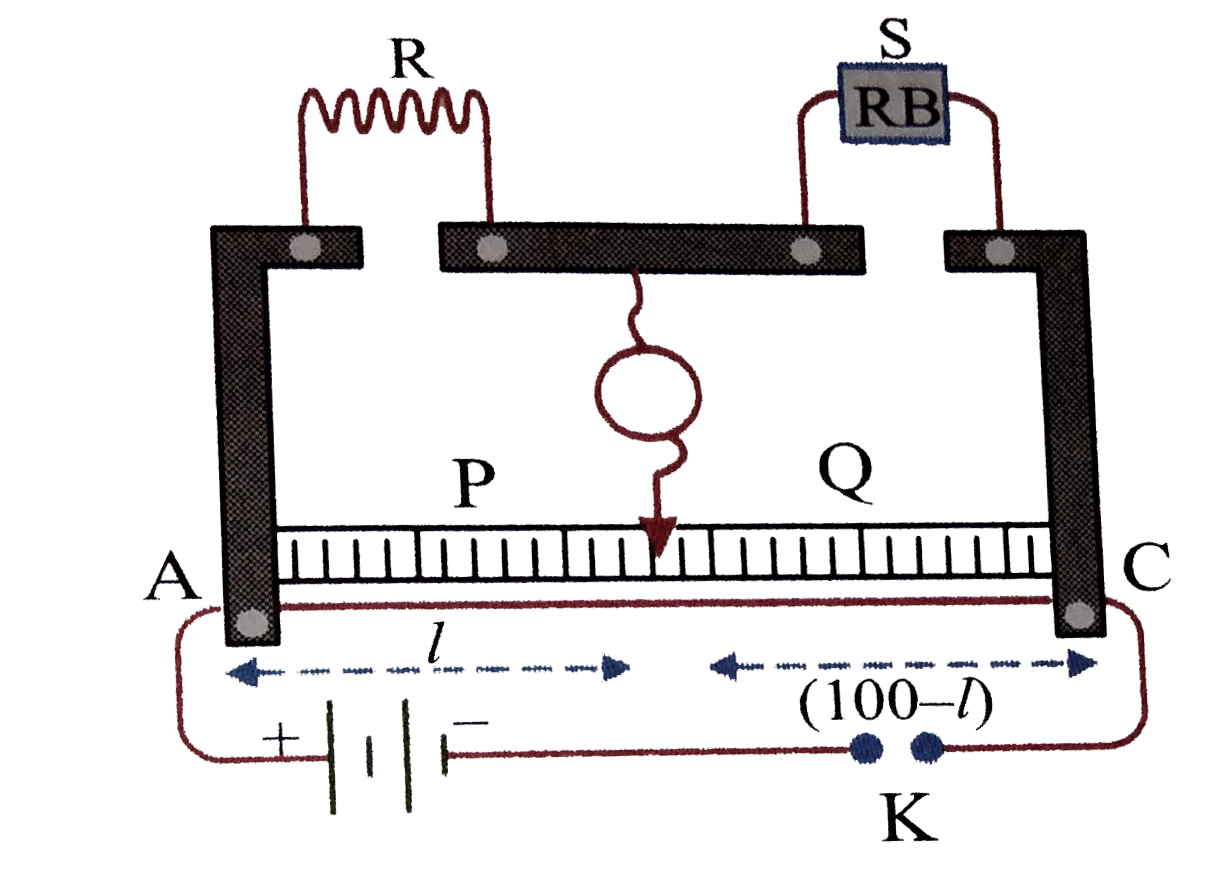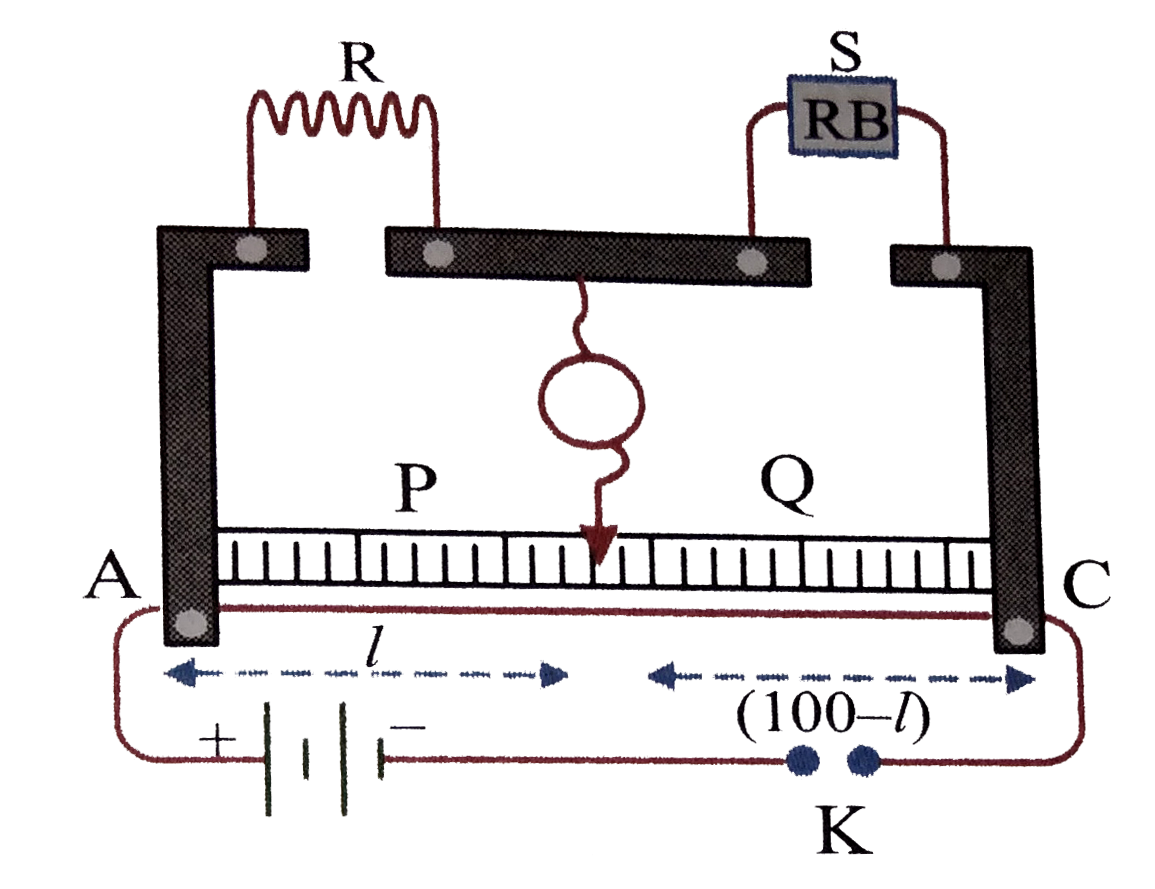Consider the meter bridge circuit without neglecting and corrections (α, β)

If the unknown Resistance calculated without using the end corraction, is R1 and using the end corrections is R2 then
R1>R2 when balanced point is in first half
R1<R2 when balanced point is in first half
R1>R2 when balanced point is in second half
R1>R2 always
The correct Answer is:A
If balance point is firsthalf say l=40
If balance point is second half say l=70
maximum permissible error in p: the specific resistivity of wire, from meter bridge is
p=πD2S4Ll100−l
Assume that know resistance in RB(S), and total length of wire is presicely known, then lets find maximum permissible error in p due to error in p due to error in measurement of l (Balance length and D(diameter of wire).
In p=In(πS4L+2InD+Inl−In(100−l))
dpp=2dDD+dll−d(100−l)(100−l)
=2dDD+dll−dl100−l
(dpp)max=2ΔDD+Δll−Δl100−l
(dpp)max due to error in l only is
=Δll+Δl100−l=Δl(100)l(100−l)
(dpp)max will be least when l(100−l)
if max imum, i.e. l=50cm
Topper's Solved these Questions
- EXPERIMENTAL PHYSICSBOOK - NARAYNACHAPTER - EXPERIMENTAL PHYSICSEXERCISE - Level-VI(Single answer)
25 Videos
- ELECTROSTATICS AND GAUSS LAWBOOK - NARAYNACHAPTER - ELECTROSTATICS AND GAUSS LAWEXERCISE - Intergers type question
11 Videos
- MAGNETISMBOOK - NARAYNACHAPTER - MAGNETISMEXERCISE - LEVEL-II (H.W)
24 Videos
Similar Questions
If the unknown Resistancee calculated without using the end correction is R1 and with using end corrections is R2 then (assume same end corection) .
View SolutionIf the unknown resistance calculated without using the end correction, is R1 and with using the end corrections is R2 then (assume same end correction at both ends)
View Solution
Knowledge Check
If the unknown Resistancee calculated without using the end correction is R1 and with using end corrections is R2 then (assume same end corection) .
AR1>R2 when balanced point is in first halfBR1>R2 when balanced point is in first halfCR1>R2 when balanced point is in first halfDR1>R2 when balanced point is in first halfConsider the meter bridge circuit without neglecting and corrections (α, β)

Now er start taking obsevation. At the position of R, unknown resistance is used, and at position of S, 300Ω resistance is used. If the balanced length was found to be l=26cm, then estimate the unknown resistance.A108ΩB105.4ΩC100ΩD110ΩIf we use 100Ω and 200Ω in place of R and X we get null point deflection, l=33cm. If we interchange the resistors, the null point length is found to be 67cm Find end corrections ∝andβ.
Aα=1cm, β=1cmBα=2cm, β=1cmCα=1cm, β=2cmDNone of these
If the unknown resistance calculated without using the end correction, is R1 and with using the end corrections is R2 then (assume same end correction at both ends)
View SolutionConsider the meter bridge circuit without neglecting and corrections (α, β)

Now start taking obsevation. At the position of R, unknown resistance is used, and at position of S, 300Ω resistance is used. If the balanced length was found to be l=26cm, then estimate the unknown resistance.
View SolutionMeter Bridge Uniform Wire with end Correction||Non Uniform Wire
View SolutionResistance of a wire is, measured using a meter bridge and the balancing length for the unknown resistance of 10ω in the right gap is 48 cm. Find the value of the resistance. If the end corrections are 0.6 cm and 0.4 cm respectively for the left and right ends, find the corrected value of the unknown resistance.
View SolutionExplain the principle of working of a meter bridge. Draw the circuit diagram for determination of an unknown resistance using it.
View Solution
